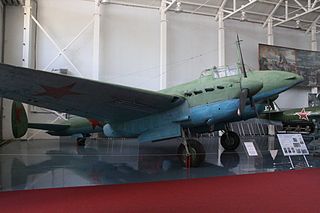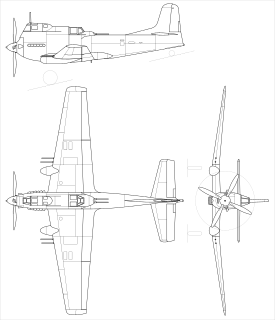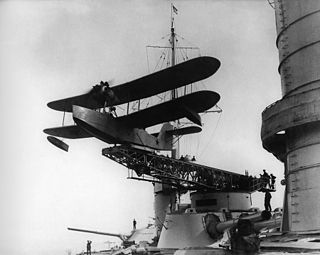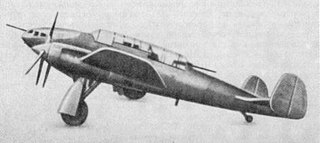Operators
 Soviet Union
Soviet Union
| Beriev MBR-7 | |
|---|---|
| Role | Short-range reconnaissance bombing flying boat |
| National origin | Soviet Union |
| Manufacturer | Beriev |
| First flight | 1937 |
The Beriev MBR-7 (sometimes Beriev MS-8) was a Soviet short-range reconnaissance/bomber flying boat developed by the Beriev design bureau at Taganrog. [1] Designed as a successor to the MBR-2 but it did not go into production due to lack of engines. [2]
The MBR-7 (Morskoy Blizhnii Razvedchik - naval short-range reconnaissance) was a similar configuration to the earlier MBR-2 but was a more advanced design. [1] A mainly wooden cantilever shoulder-wing monoplane flying-boat. [1] The Klimov M-103 inline piston engine was mounted on struts above the wing driving a pusher propeller. [1] The pilot in an enclosed cockpit in the nose had access to a fixed forward-firing machine gun, the observer/gunner sat underneath a glazed canopy. [1] The observers canopy slid forward to access a pintle-mounted ShKAS machine-gun. [1]
It had an excellent performance but due to the lack of supply of Klimov engines the decision was made to continue building the MBR-2 and the MBR-7 did not go into production. [2]
Data fromOrbis. [1]
General characteristics
Performance
Armament
Related lists

The Petlyakov Pe-2 was a Soviet twin-engine dive bomber used during World War II. One of the outstanding tactical attack aircraft of the war, it also proved successful as a heavy fighter, as a night fighter and as a reconnaissance aircraft. In many respects it resembled the wooden British de Havilland Mosquito. The Pe-2 was, numerically, the most important Soviet bomber of World War II, at their peak comprising 75% of the Soviet twin-engine bomber force. The Soviets manufactured Pe-2s in greater numbers during the war than any other twin-engine combat aircraft except for the German Junkers Ju 88 and the British Vickers Wellington. Several communist air forces flew the type after the war, when it became known by the NATO reporting name Buck.

The Kharkiv KhAI-5, was a Soviet reconnaissance and light bomber aircraft, designed in the mid-1930s in the Kharkiv Aviation Institute, under the direction of Iosif Grigorevich Nyeman.

The Yakovlev Yak-2 was a short-range Soviet light bomber/reconnaissance aircraft used during World War II. It was produced in small numbers, and most of them were destroyed during the opening stages of Operation Barbarossa.
The Yakovlev Yak-4 was a Soviet light bomber used during World War II. It was developed from the Ya-22/Yak-2.

The Beriev MBR-2 was a Soviet multi-purpose flying boat which entered service with the Soviet Navy in 1935. Out of 1,365 built, 9 were used by foreign countries including Finland and North Korea. In Soviet Union it sometimes carried the nickname of "Kорова" (cow) and "Амбар" (barn).

The Ilyushin Il-20 was a Soviet prototype for a heavily armored ground-attack aircraft to replace the Ilyushin Il-10. It featured a number of innovative concepts including a cockpit mounted on top of the engine, directly behind the propeller, and wing-mounted autocannon that could be adjusted on the ground to fire level or depressed 23° to allow the aircraft to strafe ground targets while remaining in level flight. However it was slower than the Il-10, and its M-47 engine was problematic in flight tests in 1948–49. It was not placed into production. The test pilots called the aircraft the Gorbach (Hunchback).

The Beriev Be-2 was a two-seat reconnaissance seaplane built for the Soviet Navy shortly before World War II. It was designed to replace the Navy's obsolete license-produced Heinkel He 55 aircraft operating from warships and shore bases.

The Beriev Be-4 was a reconnaissance flying boat built to operate from Soviet warships during World War II.

The Chyetverikov MDR-6 was a 1930s Soviet Union reconnaissance flying-boat aircraft, and the only successful aircraft designed by the design bureau led by Igor Chyetverikov.

The Heinkel HD 55 was a biplane flying boat produced in Germany in the early 1930s for use as a reconnaissance aircraft aboard Soviet warships. The design was based on the HD 15 mail plane of 1927 and was a conventional design for its time, with equal span, unstaggered wings, and an engine mounted tractor-wise on struts above the pilot's open cockpit. A second open cockpit was added on the rear fuselage to provide a position for a tail gunner.
The Beriev R-1 was the first Soviet turbojet-powered flying boat.
The Macchi M.8 was an Italian reconnaissance/bomber flying boat designed by Alessandro Tonini and built by Macchi. It was used by the Italian Naval Aviation and was later flown by crews from the United States Navy.

The Ilyushin Il-16 was a Soviet lightweight armored ground-attack aircraft developed at the end of World War II by the Ilyushin Design Bureau. It was in essence a scaled-down version of the Ilyushin Il-10, but was fitted with a newly developed Mikulin AM-43 engine with the expectation that it would be faster and more maneuverable than its predecessor. However, the engine's defects proved to be impossible to rectify and further development was canceled in mid-1946.

The Polikarpov VIT-1 was a Soviet twin-engined multi-purpose aircraft developed before World War II. One prototype was built in 1937, with an extremely heavy armament for ground attack duties. That was the only example built as it was decided to revise the design with more powerful engines as the VIT-2.

The Polikarpov VIT-2 was a Soviet twin-engined ground attack aircraft developed before World War II. A single prototype was built in 1938 for evaluation purposes. Although a promising design it was recommended that it be introduced into production as a high-speed dive bomber with a reduced armament to increase its speed.
The Beriev MDR-5 (sometimes Beriev MS-5) was a Soviet long-range reconnaissance/bomber flying boat prototype developed by the Beriev design bureau at Taganrog. It did not enter production as the rival Chyetverikov MDR-6 was preferred.

The Pashinin I-21 was an early 1940s Soviet fighter prototype. Designed by Mikhail M. Pashinin, the I-21 was built to incorporate lessons learned from the combat experiences of Soviet pilots during the Spanish Civil War and the Nomonhan Incident with the Empire of Japan. Despite showing promising performance, the I-21 did not get past the prototype stage, as it was felt the type did not offer a significant enough increase in capability over competitors already in production, such as the Yakovlev Yak-1 or Mikoyan Gurevich MiG-3.
The Yatsenko I-28 was a 1930s Soviet single-seat fighter designed by Vladmir Yatsenko and first flown in 1939. The I-28 was a low-wing cantilever monoplane of mixed construction powered by a 900 hp (671 kW) Tumansky M-87 radial piston engine. It had an enclosed single-seat cockpit with a rearwards sliding canopy. The wing had an inverted-gull shape to reduce the length of the retractable main landing legs. The prototype was destroyed shortly after the first flight but an order was placed for 30 production aircraft. Also ordered was a prototype of an attack version, the I-28Sh. Although the first five production aircraft were completed the programme was cancelled in early 1940.

The Shavrov Sh-7 was a Soviet civil transport amphibious aircraft designed by Vadim Shavrov. Although it was ordered into production for Aeroflot, the start of the Great Patriotic War resulted in only a single prototype being built.
The Polikarpov Ivanov was a 1930s prototype Soviet ground attack monoplane designed by Polikarpov for a soviet government procurement competition codenamed Ivanov.